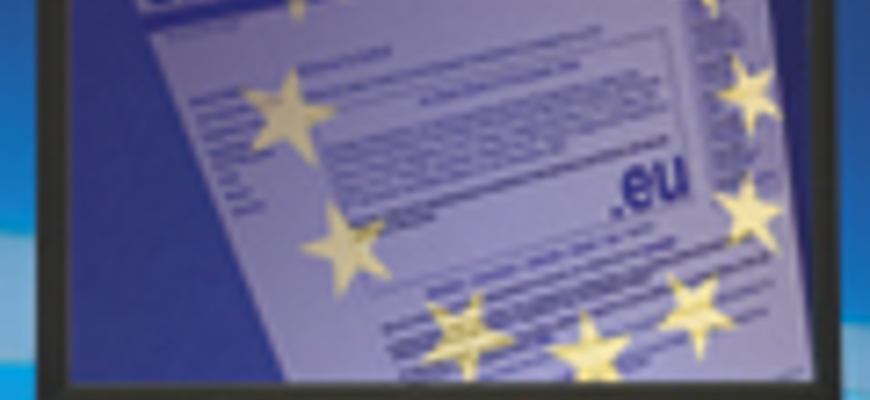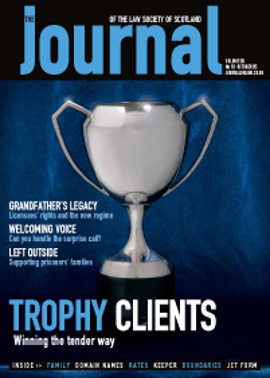Wake up to .eu

When it comes to selecting a domain name, the obvious choice for a UK business is a name ending in .uk. If the business wants to establish an international web presence, .com provides a useful alternative or additional option. Soon, however, businesses will be able to give themselves a truly European image by adopting a .eu domain name.
The rules governing registration of .eu domain names are set out in Commission Regulation (EC) No 874/2004. The Regulation provides for the establishment of a registry, the responsibilities of which include the following:
- accrediting domain name registrars;
- registering domain names applied for by accredited registrars; and
- setting up an ADR procedure to resolve disputes over domain names.
EURid in charge
In October last year, the European Commission appointed a Brussels based organisation called the European Registry for Internet Domains (EURid), to be the .eu registry. In June of this year EURid started accrediting a network of .eu registrars. These are internet service providers or other organisations that will be responsible for registering .eu domain names on behalf of clients using EURid’s automated processes. A list of accredited registrars can be found on EURid’s website at www.eurid.eu.
Who can register?
Commission Regulation (EC) No 733/2002 lists the persons that can apply to register a .eu domain name:
- undertakings having their registered office, central administration or principal place of business within the Community; or
- organisations established within the Community without prejudice to the application of national law; or
- natural persons resident in the Community.
Watching the sunrise
In an effort to stop cybersquatters, there will be a “sunrise period” during which holders of rights in domain names can beat the rush by registering their domain name in advance of general registration. Details of those who can register names during the sunrise period are set out in articles 10 to 12 of Regulation 874/2004. There will be two sunrise periods, each lasting two months. The first period will cover national and Community trade marks, geographical indications and the names and acronyms of public bodies. The second phase will cover names that can be applied for under phase 1 as well as all other prior rights. “Prior rights” are defined very widely and include unregistered trade marks, trade names, business identifiers and family names “in as far as they are protected under national law in the Member-State where they are held”.
EURid hopes to start the first sunrise period before the year end. Those hoping to take advantage of the sunrise procedure should keep a careful eye on EURid’s website (www.eurid.eu), as details of when the sunrise period will start should appear shortly.
Pre-registration issues
As noted above, applications for domain names need to be made via an accredited registrar of the applicant’s choice. EURid will not accept applications directly from applicants. Accredited registrars are currently accepting “pre-registration” requests from their clients. If accepted by the registrar this amounts to no more than an indication by the registrar that it will try to register the applicant’s name when .eu goes live. At that point, the registrar will be able to enter their pre-registration requests into EURid’s automated systems for processing. Where certain domain names have been pre-registered several times with different registrars, the automated systems will determine on a “first come, first served” basis which pre-registration request to accept.
It is certainly worthwhile for applicants to make pre-registration requests as long as they are aware that this step may not in itself be sufficient to secure the desired name. Applicants should also be aware that certain organisations are reported to be offering bogus pre-registration services, requiring payment up front in exchange for an offer to register the would-be applicant’s name. Care should be taken to ensure that registrars are included on EURid’s accredited list before entering into any pre-registration arrangements. EURid has also highlighted the practice of pooling pre-registrations between registrars with the intention of auctioning to the highest bidder the first place in the queue for that name. This practice is in breach of Regulation 874/2004.
Proving entitlement
Each application made via a registrar during the sunrise period will need to be accompanied by documentary proof of the applicant’s entitlement to the name. PricewaterhouseCoopers (“PwC”) has been appointed as the validation agent and will examine the evidence provided and decide whether it is sufficient to establish entitlement. This will be a challenging task due to the wide variety of rights that will need to be validated. PwC are likely to be presented with numerous types of documentation, in any one of the official Community languages. Further helpful information about the validation services to be offered by PwC is available at www.validation.pwc.be.
Resolving challenges
Articles 21 to 23 of Regulation 874/2004 set out the basis on which .eu registrations can be challenged, and the policy and procedures for resolving such challenges. These provisions will require to be read alongside the Dispute Resolution Rules and Supplemental Rules of the Czech Arbitration Court, the provider of the .eu ADR service. A public consultation on both sets of rules closed on 7 September and publication of the consultation responses is currently awaited – see www.arbcourt.cz/adreu.
In order to invoke the dispute resolution policy, a complainant must assert that the registration of a domain name is “speculative or abusive within the meaning of Article 21”. Article 21(1) provides that the complainant must show:
(a) that the domain name is identical or confusingly similar to a name in respect of which a right is recognised by national and/or Community law; and
(b) that the name has been registered by its holder without any rights or legitimate interest in the name; or
(c) that the name has been registered or is being used in bad faith.
A complainant who proves the above circumstances is entitled to have the disputed domain name transferred to him, assuming the complaint includes an application for transfer.
Article 21(2) explains how legitimate interest in a name may be demonstrated. Factors include the following: use in connection with an offering of goods and services (or having made demonstrable preparation to do so); being commonly known by the name; and making a legitimate and non-commercial or fair use of the name, without intention to mislead. It seems likely that the onus of proving legitimate interest will in many cases fall largely on the respondent as it will often be difficult for complainants to prove a negative.
Article 21(3) sets out various indicators of bad faith. These include circumstances indicating that registration was mainly for the purpose of selling, renting or otherwise transferring the name to a rights holder; registration as a blocking mechanism; and registration with the intention of causing disruption to a competitor.
Innovations in the process
On the face of it, the test is similar to that adopted by the ICANN (Internet Corporation for Assigned Names and Numbers) Uniform Dispute Resolution Policy (UDRP), which is used to determine disputes over generic top level domains such as .com, .info and .biz. There are, however, two main differences: (1) whereas the UDRP requires complainants to show that the respondent has both registered and used the domain name in bad faith, the .eu test requires only registration or use; and (2) whereas under the UDRP there must be both lack of legitimate interest and bad faith, it is sufficient under the .eu test to show either of these elements. The possibility of having a domain name transferred without the need to show bad faith on the respondent’s part, has caused some controversy.
One aspect that is absent from the .eu ADR process is an appeal system. Once the appointed dispute resolution panel has made a decision, it is final unless court proceedings are initiated within 30 days. The UDRP has been criticised by some for its lack of an appeal process, the concern being that there has on occasion been inconsistency in decision making, which an appeal system could go some way to correct. It will be interesting to see whether the .eu ADR process attracts similar comment.
Nominet, the organisation that administers .uk registrations, has incorporated not only an appeal process but also a mediation service into its dispute resolution service. This has proved highly successful, with settlement in around 55% of cases at mediation stage. There would undoubtedly be logistical difficulties in offering mediation in all languages; otherwise this could have been a useful additional feature of the .eu ADR process.
Beware the cybersquatter
The .eu domain name process offers a valuable opportunity for businesses to establish a European presence on the web. Businesses should also bear in mind that even if they plan to continue using only their existing name(s), the reality of cybersquatting is that if those with rights in names fail to snap them up, others will. Defensive registrations will therefore be a necessity for many. The sunrise period gives rights holders a chance to beat the rush and register their names. In addition, the ADR process will provide a relatively quick and inexpensive method of attempting to recover a domain name from a cybersquatter.
Jennifer Burke is a solicitor with The Royal Bank of Scotland Group
In this issue
- Back on the home front
- Exchanging the "missive"
- Perfect pitch
- Tales from the court
- The going rate
- Licence please
- "Your call is important to us..."
- Wake up to .eu
- Know your boundaries
- Outside in
- Checks and balances
- Policy and practice
- Supporting credentials
- Infrastructure: who pays?
- Protective awards unprotected
- Website reviews
- Book reviews
- New terms for old
- Keeper's corner






